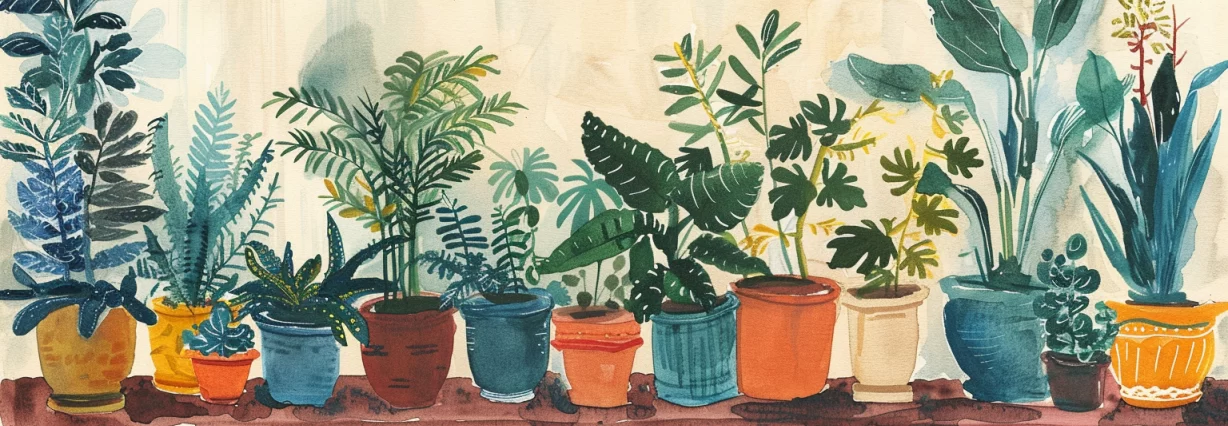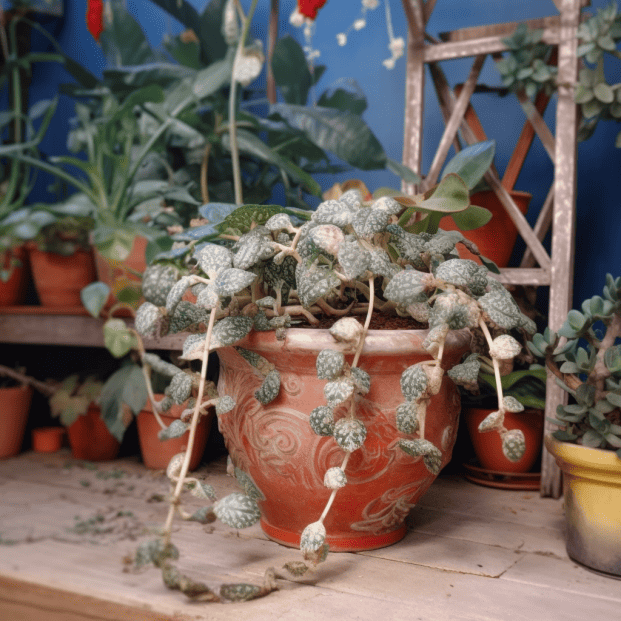Hoya curtisii is a beautiful and easy-to-care-for houseplant that is a must-have for any plant enthusiast. This plant is native to the Philippines, Malaysia, and Thailand and belongs to the Apocynaceae family. It is also known as the Wax Flower or Porcelain Flower due to its waxy, porcelain-like flowers that bloom in clusters and produce a sweet fragrance.
One of the best things about Hoya curtisii is that it is a low-maintenance plant that is perfect for beginners. It prefers bright, indirect light and well-draining soil, but can tolerate some shade and occasional neglect. It is also a slow-growing plant that can be propagated easily, making it a great addition to any plant collection. With its delicate spade-shaped leaves covered in silver variegation, it can add a touch of elegance to any room.
Hoya Curtisii Overview
This is a tropical plant that belongs to the Apocynaceae family. It is a slow-growing epiphyte, which means it grows on other plants in its native habitat. The plant is native to the Philippines, Malaysia, and Thailand, where it grows in the understory of tropical rainforests.
Botanical Name
The botanical name for this plant is Hoya curtisii. It is also commonly known as the Tiny Leaf Porcelain Flower, Fung Wax Flower, or Wax Flower.
Epiphyte
Hoya curtisii is an epiphyte, which means it grows on other plants in its native habitat. In the wild, it attaches itself to trees and uses them for support. It is an excellent plant for growing in hanging baskets or on a trellis.
Apocynaceae Family
It belongs to the Apocynaceae family, which is a family of flowering plants. This family is known for its milky sap, which is often toxic to animals and humans.
Native Habitat
It is native to the Philippines, Malaysia, and Thailand. It grows in the understory of tropical rainforests, where it attaches itself to trees for support.
Toxicity to Pets
Hoya curtisii is toxic to pets, including cats and dogs. The plant’s milky sap contains toxins that can cause vomiting, diarrhea, and other symptoms if ingested. It is important to keep this plant out of reach of pets.
Pronunciation
The pronunciation of Hoya curtisii is “HOY-ah kurt-EE-see-eye.”
Growing Hoya Curtisii
Hoya Curtisii is a beautiful and delicate plant that requires some specific care to thrive. Here are some tips to help you grow and care for your Hoya Curtisii.
Light Requirements
It prefers bright, indirect light. Direct sunlight can scorch the leaves, so it’s best to place the plant near a filtered window or in a room with bright, indirect light.
Watering
When it comes to watering, this plant prefers to dry out between waterings. It’s important not to overwater the plant, as this can lead to root rot. Allow the soil to dry out completely before thoroughly watering, allowing all the excess water to drain.
Humidity
Hoya Curtisii prefers higher humidity levels, so it’s a good idea to mist the leaves regularly or place a humidifier near the plant. This will help prevent the leaves from drying out and keep the plant looking healthy.
Soil
It grows well in any high-quality, fast-draining soil. They are epiphytes and because of that, they need a very sharply draining soil mix. A good cactus or succulent soil mixed with perlite works well. Use two parts soil and 1-part perlite for best results.
Fertilizer
Hoya Curtisii doesn’t require a lot of fertilizer, but it’s a good idea to give it a boost during the growing season. Use a balanced, water-soluble fertilizer every two weeks during the growing season. Be sure to follow the instructions on the package carefully.
Temperature
It prefers warmer temperatures between 60-85°F. Avoid placing the plant in drafts or near air conditioning units, as this can cause the leaves to dry out. Keep the plant in a warm, stable environment to help it thrive.
Overall, Hoya Curtisii is a relatively easy plant to care for. With the right light, water, humidity, soil, fertilizer, and temperature, your plant will thrive and add a beautiful touch to your home or office.
Propagation
Hoya curtisii is a popular plant that can be propagated through cuttings or seeds. Propagation is a great way to increase or share your collection with others.
Cuttings
One of the easiest ways to propagate is through stem cuttings. To propagate through cuttings, follow these steps:
- Choose a healthy stem that has at least two leaves.
- Cut the stem just below a node.
- Remove the lower leaves from the cutting.
- Dip the cut end of the stem in rooting hormone.
- Plant the cutting in a well-draining soil mix.
- Water the cutting sparingly until it roots.
Seeds
Hoya curtisii can also be propagated through seeds. However, this method requires more patience and care. Here are some steps to propagate Hoya curtisii through seeds:
- Collect the seeds from a mature Hoya curtisii plant.
- Sow the seeds in a well-draining soil mix.
- Cover the seeds lightly with soil.
- Keep the soil moist but not waterlogged.
- Place the pot in a warm, bright spot.
- Germination can take several weeks to several months.
Propagating Hoya Curtisii
Propagation can also be done through layering or division. Layering involves bending a stem to the ground and covering it with soil until it roots. Division involves separating the plant into smaller sections and planting them separately.
It is important to note that propagation can take time and patience. However, you can successfully propagate this beautiful plant with the right care and attention.
Care
Hoya curtisii is a slow-growing, vining plant that requires minimal care. However, providing the right conditions for the plant to thrive is important.
Common Pests
This plant is generally pest-resistant but can be susceptible to mealybugs, spider mites, and scale insects. These pests can be controlled by wiping the leaves with a damp cloth or using insecticidal soap.
Disease
Hoya curtisii is not prone to diseases but can be affected by fungal infections if the soil is too moist. To prevent fungal infections, it is important to ensure that the soil is well-draining and not watered excessively.
Leaf Problems
Your plant can develop yellow leaves if it is exposed to direct sunlight or if the soil is too dry. Brown spots on the leaves can be a sign of fungal infection or overwatering. It is important to identify the cause of the problem and address it accordingly.
Overwatering
Overwatering can be a problem for Hoya curtisii, as it can lead to root rot. The plant should be watered only when the soil is dry to the touch. It is also important to ensure that the pot has good drainage.
Pruning
Pruning is not necessary for Hoya curtisii, but it can help to maintain its shape and promote new growth. The plant can be pruned in the spring or summer by cutting back the stems to the desired length.
Repotting
You should repot every two to three years, or when the roots have outgrown the pot. The plant should be repotted in a well-draining soil mix and a pot that is slightly larger than the previous one. It is important to avoid disturbing the roots too much during repotting.
Blooming
This plant is known for its beautiful flowers that bloom in clusters. In this section, we will discuss the blooming period, bloom, and peduncles of Hoya curtisii.
Blooming Period
Hoya curtisii typically blooms during the summer months. The blooming period can vary depending on the growing conditions and care provided to the plant. With proper care, it can bloom multiple times throughout the year.
Bloom
The flowers of Hoya curtisii are small, star-shaped, and have a unique fragrance. The color of the flowers is typically pink or red with a white center. The blooms can last for several weeks and add a beautiful touch to any indoor space.
Peduncles
Peduncles are the stalks that hold the flowers of Hoya curtisii. The peduncles of Hoya curtisii can grow up to 2 inches long and are typically green in color. The flowers grow in clusters of 6 to 10 and can cover the entire plant when in bloom.
To encourage blooming, it is important to provide the plant with adequate light and water. Hoya curtisii prefers bright, indirect light and should be watered when the top inch of soil is dry. Fertilizing the plant once a month during the growing season can also help promote blooming.
In conclusion, Hoya curtisii is a beautiful plant that adds a touch of elegance to any indoor space. With proper care, it can bloom multiple times throughout the year, providing a stunning display of pink or red flowers with a unique fragrance.
Hoya Curtisii Varieties
Hoya curtisii is a delightful and easy-to-grow plant that belongs to the Apocynaceae family. It is a small-growing Hoya with unique and beautiful foliage, making it a popular choice among indoor plant enthusiasts. While there are not many varieties of Hoya curtisii, some variations in the leaves make it an interesting plant to add to your collection.
Variegated Leaves
One of the most popular variations of Hoya curtisii is the variegated leaves. The leaves of this variety have a unique pattern of green and white colors that make them stand out. The variegation can be in the form of speckles or stripes, and it adds a touch of elegance to the plant. Variegated Hoya curtisii is a rare find, so if you come across one, be sure to add it to your collection.
Succulent Leaves
Another variation is the succulent leaves. The leaves of this variety are thicker and have a more succulent texture than the regular Hoya curtisii. The succulent leaves make the plant look more robust and give it a unique appearance. The succulent leaves also help the plant to retain more water, making it more tolerant to drought conditions.
While there are not many varieties, the variegated and succulent leaf variations make it an interesting plant to grow. Whether you are a beginner or an experienced indoor plant enthusiast, Hoya curtisii is a plant that you will enjoy growing.
Using Hoya Curtisii
Hoya curtisii is a wonderful plant that can be used in a variety of ways to add beauty and charm to any space. Here are some ideas for how to use hoya curtisii in your home:
Hanging Baskets
One of the best ways to showcase this plant is in a hanging basket. The plant’s trailing vines and delicate leaves look stunning when allowed to spill over the edges of a container. Hanging baskets are also a great way to save space and add visual interest to a room. Hoya curtisii is a perfect plant for a hanging basket because it is relatively small and lightweight, making it easy to hang from a hook or bracket.
Small Spaces
If you have a small space, hoya curtisii can be a great way to add some greenery without taking up too much room. The plant’s compact size and slow growth rate make it perfect for small apartments, dorm rooms, or offices. It can be grown in a small pot on a windowsill or desk, or placed on a shelf or bookcase to add some height and interest to a room.
Fragrance
Hoya curtisii is known for its sweet fragrance, which is most noticeable in the evening when the plant’s flowers open up. The scent is reminiscent of honey or vanilla, filling a room with a pleasant aroma. If you want to enjoy the fragrance of hoya curtisii, place the plant in a well-lit area where it can receive plenty of sunlight and water it regularly to encourage blooming.
In conclusion, this is a versatile plant that can be used in a variety of ways to add beauty and charm to any space. Whether you grow it in a hanging basket or small space or simply enjoy its sweet fragrance, hoya curtisii will surely delight and impress.
Conclusion
Hoya curtisii is a beautiful and unique houseplant that can add a touch of elegance to any space. With proper care and attention, this plant can thrive and produce stunning blooms that will enhance the overall aesthetic of your home.
One of the key factors in caring for your plant is ensuring that it has the right soil mix. As an epiphyte, this plant requires a well-draining soil that allows water to flow through quickly. A mix of cactus or succulent soil mixed with perlite is an excellent choice for this plant.
In terms of lighting, Hoya curtisii prefers bright, indirect light. Direct sunlight can scorch the leaves, so finding a spot that provides ample light without exposing the plant to direct sunlight is important.
Another crucial aspect of caring for this plant is maintaining consistent moisture levels. This plant prefers to be kept slightly moist, but not overly wet. Overwatering can lead to root rot, while underwatering can cause the plant to wilt and die.
Overall, it is a fantastic choice for anyone looking to add a touch of natural beauty to their home. With the right care and attention, this plant can thrive and produce stunning blooms that will delight and amaze anyone who sees them.
Frequently Asked Questions
What is the ideal temperature for Hoya Curtisii?
It thrives in temperatures between 60°F to 80°F (15°C to 27°C). It is important to avoid exposing the plant to temperatures below 50°F (10°C) or above 90°F (32°C).
What kind of soil is best for Hoya Curtisii?
They prefer well-draining soil that is rich in organic matter. A good mix consists of equal parts of peat moss, perlite, and vermiculite.
How often should I water Hoya Curtisii?
Hoya Curtisii prefers to dry out between waterings. Generally, it is best to thoroughly water the plant and allow the soil to dry out before watering again. Overwatering can lead to root rot, so it is important to ensure the soil is not waterlogged.
What is the best lighting for Hoya Curtisii?
It prefers bright, indirect light. Direct sunlight can scorch the leaves and cause damage to the plant. Placing the plant near a north-facing window or providing it with artificial light can help it thrive.
What are some common pests that affect Hoya Curtisii?
This plant is susceptible to mealybugs, spider mites, and scale insects. Regularly inspecting the plant for signs of infestation and treating it promptly can help prevent these pests from causing significant damage.
How can I propagate Hoya Curtisii?
You can be propagated through stem cuttings. The cuttings should be taken from the tips of healthy stems and allowed to callus over before being planted in well-draining soil. It is important to keep the soil moist and provide the plant with bright, indirect light during propagation.


